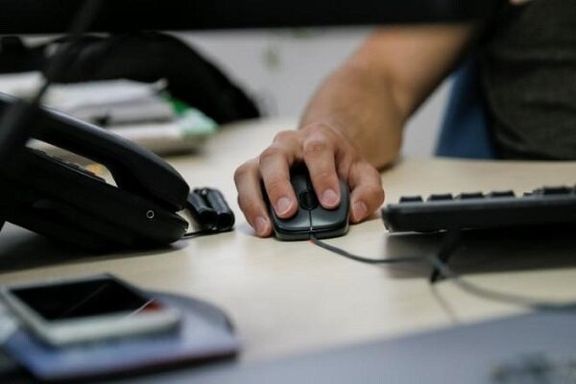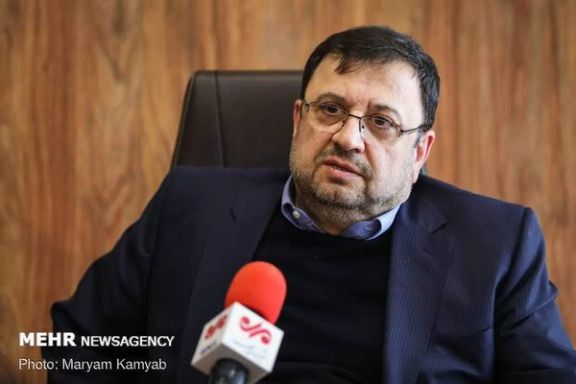Iran Regime Uses Social Media Accounts Of Detainees To Incriminate Them

Reports from Iran say that the regime officials use private chats, phone logs and text messages of protest detainees as incriminating evidence.

Reports from Iran say that the regime officials use private chats, phone logs and text messages of protest detainees as incriminating evidence.
CNN on Monday quoted an Iranian woman who says she has been accused by Iranian authorities of running an anti-regime activist group on Telegram.
The woman introduced as Negin has denied the allegation, but she has told CNN she has “some friends” who were political prisoners.
“They put in front of me transcribed printouts of my phone conversations with those friends,” she said, and “questioned me on what my relationship with those people were.”
“They told me ‘Do you think you can get out of here alive? We will execute you. Your sentence is death penalty. We have evidence, we are aware of everything,’” said Negin, which is not her real name.
Negin said that she realized security agents accessed her Telegram account with a different IP address.
Iranian regime reactivated her Telegram account to see who has been in touch with her while Negin was in jail, she added.
Negin was one of hundreds of protesters detained at Iran’s notorious Evin prison in northern Tehran within the first few weeks of anti-government protests following the death of Mahsa Amini in police custody in mid-September.
The Iranian government may have used similar tactics to surveil the Telegram and Instagram accounts of Nika Shahkarami, the 16-year-old demonstrator who lost her life after a protest in Tehran on September 20.

Unknown people attacked four Shiite clerics with sharp objects in the religious city of Qom, with to hospitalized as similar incidents have taken place in recent months.
The public relations office of Qom University of Medical Sciences announced that the four clerics were wounded by a sharp object, but another source said they were hit by shotgun pellets.
Tasnim website quoted Qom University of Medical Sciences as saying that before noon on Sunday, unknown people injured four mullahs in “several different regions” of the city, and two of them were taken to the hospital for treatment, for injuries in the shoulder and leg.
Before the eruption of anti-regime protests in mid-September, several cases of attacks on clerics had been reported in Iran. On August 29, two who were introduced as imams of mosques in Qom, were attacked with an “iron pipe”.
Before that, a young mullah was attacked with a knife in the evening of July 28 in Karaj, west of Tehran.
On July 1, Iranian media reported that the imam of a mosque in Isfahan was attacked by an unknown motorcyclist with a firearm.
During the recent protests against clerical rulers following the death of Mahsa Amini in police custody, youth tossed turbans of many mullahs in the streets to show their anger at them.

Members of Russia's Pussy Riot band were detained on Sunday after trying to storm the pitch at the World Cup final in Qatar to protest the war in Ukraine, the imprisonment of Russian opposition leader Alexei Navalny and the oppression of women in Iran, activists said.
According to the Cinema for Peace Foundation, a Berlin-based charity that focuses on humanitarian and environmental issues, security detained member Nika Nikulshina, an associate of the protest group, Peter Verzilov, and a Ukrainian member of Pussy Riot.
Reuters was not able to independently verify the reports.
The activists were stopped by security forces before they could invade the pitch, Cinema for Peace said in a statement.
Jaka Bizilj, founder of the Cinema for Peace Foundation, told Reuters that Verzilov told him that he was pulled back by security forces seconds before entering the pitch.
"When I texted with Peter he was in police detention," Bizilj said.
Iran's clerical rulers have faced the biggest protests in years since September when 22-year-old Iranian Kurdish woman Mahsa Amini died in the custody of the morality police who enforce strict dress codes.
The 2018 World Cup final in Moscow was briefly interrupted when Pussy Riot activists, including Verzilov, burst onto the pitch to draw attention to human rights abuses in Russia before being hauled off by stewards.
Cinema for Peace evacuated Verzilov after the 2018 World Cup in Moscow for treatment for alleged poisoning. The foundation also brought Navalny in 2020 from Russia to Berlin for life-saving treatment after his poisoning.
Reuters Report

A top university professor in Iran has harshly criticized comments by a science ministry official regarding study opportunities for students in North Korea.
After meeting with the North Korean ambassador, the head of the Student Affairs Organization of the Ministry of Science said professors and students can take advantage of exchange programs with the isolated country.
Prof. Mehdi Zakerian said, “I have studied and lived in the United States and France, I have not been to North Korea, but I know there is not even the possibility of accessing the Internet in this country.” He was speaking to Khabaronline website in tehran.
“How is that the children of our officials study in the US and Europe, but advise other students to go North Korea to study?” he asked.
Many Iranian regime insiders have sent their sons and daughters to study and live in North America and Europe, while they continue to support the anti-West rhetoric and policies of the Islamic government. Some regime officials said in recent years that up to 4,000 family members of current or former officials live in the West.
Canada in October banned 10,000 members of Iran’s Revolutionary Guards from entering its territory and reports say that Ottawa is investigating to see if there are undesirable individuals currently living in the country.

Claims by Iranian officials that a female doctor who died with unusual injuries committed “suicide” has sparked suspicions of yet another death in custody.
The family of Dr. Aida Rostami were contacted by the local police the day after her disappearance, December 12, a source close to the family told Iran Wire Friday and that she had died in a car accident. The police said the body was at the morgue of Behesht-e Zahra Cemetery in the south of the capital Tehran.
The authorities insisted, when they handed over the body to the family, that they should bury her in their hometown of Gorgan in northeastern Iran. According to the source, the family first resisted the pressure but later accepted the request, as their daughter had previously expressed a desire to be buried in her hometown if she ever died.
The source also said medical examiners told the family, apparently in confidence, that she was not killed in a car accident, as the police had told the family, but that they were ordered not to reveal the true cause of death.
Sources close to the family have said when the they insisted to view the body, they saw various injuries and bruises, including on her genitals, and broken arms. The lids of one of the eyes of the young doctor were stitched together, apparently to conceal the removal of the eyeball.
Judiciary authorities are now offering a completely different account of the circumstances of the young doctor’s death and have arrested a young man who they claim is suspected of throwing Dr. Rostami to her death from a pedestrian overpass after a quarrel over their relationship.
State media on Sunday published a video of the unnamed man who claimed Rostami was his girlfriend and that she had thrown herself from a pedestrian bridge after he left her and that he returned to find her body on the ground.
Donya Farhadi, an architecture student, whose body was recently found ,was a protester
Authorities have explained the death of several young protesters in the past three months in similar ways, including the suspicious deaths of two teenagers in Tehran and Karaj in late September and early October. Authorities claimed Nika Shakarami and Sarina Esmailzadeh had both jumped to their deaths from the top of buildings.
The death of Aylar Haqqi (Haghi), a 23-year-old medical student, whose body was found in a construction site in Tabriz on November 15, was also explained in the same way, although her relatives claim she was shot with shotgun pellets before her injured body was thrown down from the top of a building on the site.
Families or sources close to the families of these young women have all said they were subjected to pressure and intimidation by security and intelligence forces who wanted them to validate their “scripted” accounts of their deaths.
On Friday another young woman’s body was found on the banks of Karoun River in a village near Ahvaz in southwest Iran by the locals. Authorities claim Donya Farhadi, a twenty-one-year-old student had fallen into the river from a bridge. Local sources have said on social media that the young woman was an active participant in the recent student protests.
Dr Rostami, 36, was last heard of on the evening of December 12 when she called her mother to say she was on her way to a wounded protester she was secretly treating and needed to buy more medical supplies. At that time she was in Ekbatan, a massive apartment complex in the west of Tehran, where she and her family also resided.
In the past three months Ekbatan has been one of the major hotspots of protests and frequent crackdowns by security forces who on some occasions have fired shotguns at windows indiscriminately to silence people chanting from inside their apartments every night.
An informed source told Iran International that Dr Rostami had been secretly treating protesters who feared arrest if they sought treatment for injuries and bullet wounds at hospitals, where agents usually wait to arrest protesters.

Frustrated over how to block the Internet that savvy Iranians would not circumvent, the Islamic Republic seems to be about shutting down access to the WWW.
The regime has given a 10-day deadline to the American company Meta Platforms, the owner of WhatsApp Messenger and Instagram, to establish offices in the country if they want its applications unblocked. The purpose of this move is to have control over its activities, a demand snubbed by the company.
Facebook, YouTube and Twitter are also blocked. Instagram is the only major international platform still accessible, which Iranians use extensively to conduct ecommerce. This is one major impediment to parliament’s plan for shutting down all foreign social media networks.
The demand had already seemed unreal, but many believe that the regime wanted to have an excuse to block the media platforms for good as it seems unable to stop the flow of information about the protests both within the country and to the outside world.
"If Meta does not respond to our letter, this could be the prologue to a permanent block," National Cyber Centre chief Abolhassan Firouzabadi said in a newspaper interview on Saturday.

In remarks that were denied later, Interior Minister Ahmad Vahidi had threatened to permanently block WhatsApp and Instagram.
The Islamic Republic moved a couple of time to cut access to world Internet and replace it with an intranet which can be controlled by its intelligence services but one of the hurdles has always been the country’s banking network, which operates through the Internet. But on Sunday, Iran’s Interbank Information Transfer Network electronic banking system ordered all its subsidiaries to change their domains from .com extensions to .ir, which is dedicated to Iranian domains.
Many experts have expressed concerns about the move. Mohammad Mahdi Shariatmadar, the Chairman of the Board of Directors of the FinTech Association, called the "sudden" decision worrisome, saying that "I don't think new or even old payment partners will be able to continue operating with this method."
Milad Jahandar, the CEO of one of the online payment companies, said that the right to choose a domain is an obvious right of any company, noting that such a level of restriction in which the regulator even determines a domain name is unprecedented in the world.
Since January, Iran’s hardliner parliament has been discussing ways to intensify Internet censorship by establishing an intranet that would essentially ban foreign social media networks which allow Iranians to receive uncensored information and communicate with others.
The government has blocked thousands of websites in Iran for nearly 20 years both for ideological and political reasons. Almost all news and political websites not controlled by the government are inaccessible except by special software people need to use to get around the filtering.
Since the current round of protests began across the country in mid-September, a bipartisan group of US lawmakers are working with the US Treasury Secretary Janet Yellen to give Elon Musk’s satellite Internet service Starlink clearance to operate in Iran. The SpaceX CEO is trying to connect its internet services to users across Iran, a move that would be seen as the end of the Islamic Republic internet restriction policies.
In October, the US Department of State released a statement condemning Iran’s restrictions on access during nationwide protests over the death of Mahsa Amini.
“The United States is pleased to join the Freedom Online Coalition’s consensus Joint Statement on Internet Shutdowns in Iran,” reads the statement.
The Freedom Online Coalition is made up of 34 governments that collaborate to advance internet freedom worldwide.